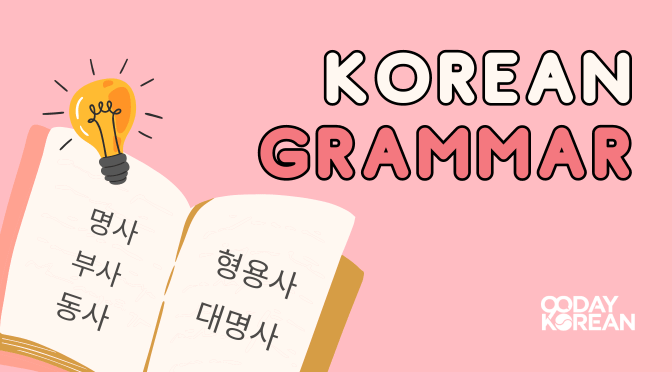Learning Korean? If you’re studying the Korean language, then you’ll need to have your Korean grammar down!
Today, we’ll teach you the basics of Korean grammar so you can start forming sentences that mean exactly what you want to say.
Ready to become a grammar master? Let’s learn the basics of Korean grammar!
Here is an easy-to-learn Korean PDF on Korean Grammar that you can download and take with you:
Contents
Korean Grammar in Use
Korean grammar, like any other language, has a lot of rules and topics to cover. However, you don’t need to know everything and the more advanced topic as you’re starting. You’ll only need to know the Korean grammar in use.
These are basic grammar topics and rules that you’ll need to know to bring your Korean skills to the next level.
Below, we’ll explain Korean grammar in use with Hangeul (Korean Alphabet) and in Romanized English. You can learn the Korean Alphabet in under an hour here.
Is Korean grammar difficult?
It wouldn’t be accurate to say that Korean grammar is difficult or easy. Like many Asian languages, the grammar is quite different from English. But like the grammar of any foreign language, Korean grammar follows the rules and sentence structure that makes sense.
In fact, Korean grammar is pretty straightforward. This gives you more reason to love and learn Korean! You just need to get used to the primary quirk of its grammar.
You may know that English basic grammar follows the structure:
SUBJECT (S) + VERB (V) + OBJECT (O)
For example, I (subject) study (verb) Korean (object). Most languages have an SVO grammar structure like this. The action leads the object so you know what is happening before you know what it’s happening to.
How are Korean sentences structured?
Basic Korean grammar, on the other hand, uses the order:
SUBJECT (S) + OBJECT (O) + VERB (V).
For native speakers of languages that use the SVO grammar structure, such as English, this may sound confusing and incorrect.
Korean, Japanese, and to some extent German, all use SOV in their grammar. You’ll understand why this kind of grammar makes sense when forming a Korean sentence later in the lesson. For now, here are some examples of the sentence structure of Korean to help you get acquainted with the grammar:
Example 1: I ate an orange.
나는 오렌지를 먹었어요.
(naneun orenjireul meogeosseoyo)
I + orange + ate
Example 2: My big brother plays football.
오빠가 축구를 해요.
(oppaga chukgureul haeyo)
Big brother + football + to do
Example 3: I meet my friend.
나는 친구를 만나요.
(naneun chingureul mannayo)
I + friend + to meet
To understand why the Korean language uses grammar like this, you need to understand a bit about Korean verbs and how they work.
We’ll give you a quick introduction and explanation of how Korean verbs work in Korean grammar below. But before we get into Korean verbs, let’s learn about the other parts of speech:
- Korean nouns
- Korean pronouns
- Korean Particles
- Korean Adjectives
Korean Nouns
In any language, the first basic part of speech we all learn is the noun. We start building our vocabulary and knowledge of the language with nouns. Once we know them, we can easily build phrases or simple sentences.
Korean nouns are called 명사 (myeongsa). They are made plural by adding 들 after the noun. However, some nouns, like in the English language, don’t need 들 for them to be made plural as they’re already understood as plural nouns.
For example:
학생 → 학생들
남자 → 남자들
사람 → 사람들
책 → 책들
꽃 → 꽃들
Korean nouns are used as subjects and objects in sentences. The particles 이 and 가 are used when Korean nouns are used as a subject. On the other hand, the topic markers 을 and 를 are used when a Korean noun is used as an object in a sentence.
Example 1: Hyerim is eating an apple.
혜림이 사과를 먹고 있어요.
(hyerimi sagwareul meokgo isseoyo.)
Example 2: The students read a Science book.
학생들이 과학 책을 읽어요.
(haksaengdeuri gwahak chaegeul ilgeoyo.)
To know more about Korean nouns, we have lessons on Body Parts in Korean, Animals in Korean, Fruits, Nuts, and Vegetables in Korean, Fish in Korean, and Jobs in Korean to help you get started.
Korean Pronouns
Korean pronouns are a very important part of Korean grammar, especially in daily conversations. It’s also important to know that, unlike English pronouns, Korean pronouns can vary in terms of formality.
If you are speaking to someone of a higher position or social status, you should use Korean pronouns that are formal. It would be offensive to Koreans if you use Korean pronouns that are not appropriate to the relationship or the social status between you and the person you’re talking to or talking about.
Here is a resource that will help you learn about the basic Korean pronouns.
Korean Particles
Korean particles are also another important part of Korean grammar. Without Korean particles, Korean sentences wouldn’t be complete. In general, Korean particles can have many functions but can be summarized as subject/object markers and indicators.
If you plan to be fluent in Korean, you’ll need to learn and understand how to properly use Korean particles. Here’s a resource for you to learn the most commonly used Korean particles.
Korean Adjectives
Korean adjectives make story-telling and daily conversations easier and more fun. They help us describe and give a clear picture of nouns.
Korean adjectives are called 형용사 (hyeongyongsa) in Korean. They usually take the 하다 (hada) form.
For example:
- 시원하다 (siwonhada) → to be cool
- 따뜻하다 (ttatteutada) → to be warm
- 깨끗하다 (kkaekkeutada) → to be clean
- 유명하다 (yumyeonghada) → to be famous
- 똑똑하다 (ttokttokada) → to be smart
- 착하다 (chakada) → to be nice
- 건강하다 (geonganghada) → to be healthy
But it’s important to note that not all words ending with 하다 (hada) are adjectives.
For example:
- 많다 (manta) → to be much
- 적다 (jeokda) → to be a little
- 작다 (jakda) → to be small
- 크다 (keuda) → to be big
- 멀다 (meolda) → to be far
- 싸다 (ssada) → to be cheap
- 비싸다 (bissada) → to be expensive
- 가깝다 (gakkapda) → to be near
- 나쁘다 (nappeuda) → to be bad
When describing nouns with Korean adjectives, they usually take the Korean adjective + Korean noun form. This is similar to how we describe nouns in English.
For example:
- 비싼 시계 (bissan sigye) → an expensive watch
- 착한 남자 (chakan namja) → a nice guy
- 따뜻한 사람 (ttatteutan saram) → a warmhearted person
Korean adjectives are also like verbs. They are descriptive verbs and go at the end of a Korean sentence. And because they go at the end of a sentence, they also use the same verb endings when conjugated.
For example:
오늘은 날씨가 더워요. (oneureun nalssiga deowoyo.)
Today’s weather is hot.
이 시계는 비싸요. (i sigyeneun bissayo.)
This watch is expensive.
To learn more about Korean adjectives here’s a resource for you called Korean Adjectives – Descriptive verbs and how to conjugate them.
Basic Korean Verbs
Verbs are one of the most important parts of speech in Korean grammar. They’re called 동사 (dongsa) in Korean. The beauty of Korean verbs comes from the fact that by simply learning them and their correct conjugated forms, you’re able to form a sentence.
In Korean grammar, the verb needs to be conjugated based on the context. This means that Korean verbs follow certain grammar rules that control how they’re spelled.
You’ll conjugate the word depending on its tense, level of politeness, and whether the connecting vocabulary ends in a vowel or consonant.
For example, the verb 자다 (jada). This means “to sleep”. This word will be spelled differently depending on certain grammar rules, such as tenses.
- Polite Present tense: 자요 (jayo)
- Polite Past tense: 잤어요 (jasseoyo)
- Polite Future tense: 잘 거예요 (jal geoyeyo)
- Polite Present progressive: 자고 있어요 (jago isseoyo)
However, the form does not change depending on the subject! So you don’t have to worry about the Korean particle changing (a topic for another article).
Let’s dive a bit further into this grammar point with some examples of conjugation. Note that we’ll mention Korean honorific verbs. Go here if you’re not familiar with them yet.
“To be” in Korean
The verb “to be” in Korean is 이다 (ida). This is usually when you want to specify something or when the subject and predicate are the same.
For example:
저는 중국사람이에요. (jeoneun jungguksaramieyo.)
I’m Chinese.
석민 씨는 가수예요. (seongmin ssineun gasuyeyo.)
Seokmin is a singer.
The Korean verb 이다 (ida) can be conjugated as 예요 (yeyo) or 이에요 (ieyo) or 입니다 (imnida).
“To have” in Korean
The verb “to have” in Korean is 있다 (itda). This is also used when expressing that something exists. When used in sentences, 있다 (itda) is conjugated as 있어요 (isseoyo) or 있습니다 (itseumnida).
For example:
신용 카드 있어요. (sinyong kadeu isseoyo.)
I have a credit card.
핸드폰 있어요? (haendeupon isseoyo?)
Do you have a cell phone?
책상 위에 책이 있어요. (chaeksang wie chaegi isseoyo.)
There is a book on the desk.
“To not have” in Korean
The verb “to not have” in Korean is 없다 (eopda). This is the opposite of the Korean verb 있다 (itda).
Similar to the 있다 (itda), 없다 (eopda) is conjugated as 없어요 (eopseoyo) or 없습니다 (eopseumnida) depending on the level of politeness you want to convey.
For example:
저는 언니가 없어요. (jeoneun eonniga eopseoyo.)
I don’t have a sister.
수연 씨는 고양이 없어요. (suyeon ssineun goyangi eopseoyo.)
Suyeon doesn’t have a cat.
냉장고에 우유가 없어요. (naengjanggoe uyuga eopseoyo.)
There is no milk in the refrigerator.
“To do” in Korean
The verb “to do” in Korean is 하다 (hada). You’ll often see this verb attached to many Korean verbs.
For example:
노래하다 (noraehada) → To sing
요리하다 (yorihada) → To cook
공부하다 (gongbuhada) → To study
말하다 (malhada) → To speak
Korean Adverbs
Korean adverbs help describe verbs and adjectives similar to how they work in English grammar. They are called 부사 (busa) in Korean.
Many Korean adverbs are from other forms, such as verbs and adjectives.
There are 3 common forms of Korean Adverbs.
The first form is -이 (-i).
For example:
- 완전하다 (wanjeonhada) – Complete → 완전히 (wanjeonhi) – completely
- 편하다 (pyeonhada) comfortable → 편히 (pyeonhi) – comfortably
- 솔직하다 (soljikada) – honest → 솔직히 (soljiki) – honestly
The second form is -게 (-ge)
For example:
- 빠르다 (ppareuda) – quick → 빠르게 (ppareuge) – quickly
- 맛있다 (masitda) – delcious → 맛있게 (masitge) – deliciously
- 멋지다 (meotjida) – awesome → 멋지게 (meotjige) awesomely
The third form is -으로 (-euro) or 적으로 (jeogeuro)
For example:
- 사적 (sajeok) – personal → 사적으로 (sajeogeuro) personally
- 공식 (gongsik) – official → 공식적으로 (gongsikjeogeuro) – officially
- 일반 (ilban) – common → 일반적으로 (ilbanjeogeuro) – commonly
Other Korean adverbs
There are also adverbs that aren’t from verbs/adjectives. A few of them are 잘 (jal), 매우 (maeu), and 바로 (baro).
For example:
나는 글씨를 잘 써요. (naneun geulssireul jal sseoyo.)
I write well.
그녀는 매우 아름다워요. (geunyeoneun maeu areumdawoyo.)
She is very beautiful.
나는 학교에서 바로 집에 왔어요. (naneun hakgyoeseo baro jibe wasseoyo.)
I came home straight from school.
Korean Adverbs of Frequency
They are used to describe how often an adjective, action, or verb happens.
Two examples of Korean adverbs of frequency are 항상 (hangsang) and 자주 (jaju). Below are sample sentences of both adverbs.
저는 항상 안전운전을 해요. (jeoneun hangsang anjeonunjeoneul haeyo.)
I always drive safely.
저는 자주 책을 읽어요. (jeoneun jaju chaegeul ilgeoyo.)
I often read books.
Korean Adverbs of Place
These are adverbs that help describe or modify adjectives and verbs. They help you know where the word it modifies happens.
Two examples of Korean adverbs of place are 야외 (yaoe) and 밖에 (bakke). Below are sample sentences of both adverbs.
야외에서 우리는 많은 이야기를 했어요. (yaoeeseo urineun maneun iyagireul haesseoyo.)
We talked a lot outdoors.
학생들은 밖에서 놀았어요. (haksaengdeureun bakkeseo norasseoyo.)
The students played outside.
Korean Adverbs of Time
Two examples of Korean Adverbs of Time are 지금 (jigeum) and 매년 (maenyeon). Below are sample sentences of both adverbs.
저는 지금 피곤해요. (jeoneun jigeum pigonhaeyo.)
매년 겨울은 무척 추워요. (maenyeon gyeoureun mucheok chuwoyo.)
Every winter, the weather is especially cold.
Korean Conjugation
One of the basic Korean grammar rules you need to learn is conjugation. In Korean grammar, there are 2 things you can conjugate. These are verbs and adjectives.
Korean conjugations determine the meaning, tense, tone, and mood of sentences. It’s important to learn Korean verb conjugation as you progress in learning Korean. Below is a list of the common conjugations of verbs according to their tenses.
- Verb + ㅂ니다/습니다 (ㅂ nida/seumnida) = honorific verb, present
- Verb + 아요/어요 (ayo/eoyo) = polite/formal verb, present
- Verb + 야/이야 (ya/iya) = casual/informal verb, present
- Verb + 았어요/었어요 (asseoyo/eosseoyo) = polite/formal verb, past
- Verb + 았어/었어 (asseo/eosseo) = casual/informal verb, past
- Verb + 겠어요 (gesseoyo) = polite/formal verb, future
- Verb + ㄹ/을 거예요 (ㄹ/eul geoyeyo) = polite/formal verb, future
- Verb + 겠어 (gesseo) = casual/informal verb, future
- Verb + ㄹ/을 거야 (ㄹ /eul geoya) = casual/informal verb, future
One plus about Korean verbs is that they generally stick to their conjugation rules, which makes it easier to know the correct grammar structure to follow in a given situation. This helps with deciding what to include in your grammar and vocabulary studies.
Check out this article for a detailed explanation of Korean Conjugations.
Korean Negative Verb Form
Turning sentences into negatives was already mentioned when we introduced you to 없다 (eopda). Let’s briefly go over some other negative verb forms in Korean grammar.
By adding 안 (an) in front of the verb, excluding 있다 (itda), you are creating a negative. For example:
- = I don’t have class today
- = I am not going to the US
By adding ~지 않다 (~ji anta) to the verb stem, you are also creating a negative. Like this:
- = I don’t have class today
- = I am not going to the US
*Note: This is not typically the most natural way to express it, although it is grammatically correct.
These two grammar forms are identical in their meaning. With practice, you’ll learn which situations 안 (an) and ~지 않다 (~ ji anta)sound most natural for.
One note before you finish is their use of the verb 하다. With 안, you will add the negative right in front of 하다, breaking it into an object + verb, like this:
- → = to cook → did not cook
With ~지 않다 (~ ji anta), you will keep it intact and instead add the negative at the end, like this:
- → = to cook → did not cook
Again, both grammar forms are correct, so practice to get a feel for what sounds most natural for you!
Korean punctuation
Korean punctuation is similar to the punctuation marks used in the English language. They are called 문장무호 (munjangmuho) in Korean.
There are 12 Korean punctuation marks. These are the following punctuation marks used in the Korean language:
- Period
- Commas
- Question mark
- Exclamation Mark
- Single quotation mark
- Double quotation mark
- Ellipsis
- Colon
- Tilde
- Slash
- Parentheses
- Middle dot
Learning them is important when writing essays, formal letters, emails, or academic papers.
You can find more about these punctuation marks in our lesson on Korean Punctuation.
Korean Grammar PDF
In this section, you’ll get a Korean grammar PDF with important grammar lesson points that you can download, print, and use.
Here’s how you can use the PDF:
- Read one lesson at a time. Each lesson discusses a grammar point or a pattern that can help you build Korean sentences.
- After reading one lesson, try to use the grammar point in creating your own sentence.
- Use the Korean words you already know to fill in the grammar points in each lesson. It will help you build more sentences if you have a good amount of Korean vocabulary.
Other helpful resources
Congratulations! You have now learned the basics of Korean grammar. It’s not that hard to learn Korean, after all. This is an essential first step in learning Korean and we’ve got lots more great Korean lessons to help you learn Korean. You might be interested in these topics as well:
- Get a plan for learning Korean here
- If you want to learn everything about South Korea, go here
- Head over here if you are interested in K-Pop, K-Dramas, or Korean movies
- Check out this page for lots of useful Korean phrases
- Get some of the most common Korean words here
- Go here to learn about Korean culture
- You can find Korean textbook recommendations here
Stick with us, and we’ll make Korean language learning fun and easy to learn!
Photo Credit: Bigstock









Hello! Im a little confused where to start with learning Korean, ive memorized the alphabet and im starting on numbers for the native number system and sino number system where do i go from here?
Hi Avalia! Thanks for your comment! It’s a common challenge for Korean learners to feel confused on where to start with learning Korean. I suggest giving yourself some kind of structure so that you know you’re making progress. ^^ Since you’ve already memorized the Korean Alphabet, you can follow the lessons on How-To Guide for Language Study to help you further.
i am still confused please give me tips so can understand verb and adj please i need help
Thanks for your comment! ^^ You can check our articles below to help you in learning Korean verbs and adjectives:
Korean Verbs – The Complete List of Passive, Action, Irregular, and Adjective Words
Korean Adjectives – Descriptive verbs and how to conjugate them
If you want, you can also check our blog and visit our YouTube channel for articles and videos with great Korean content.
I am confuse that sometimes we use jeoneun and sometimes other word??
Hello Aarohi, you may use 나는 (naneun) instead of 저는 (jeoneun), when speaking casually. 저 is a humble form of 나, which can be used in polite/formal speech. ^^